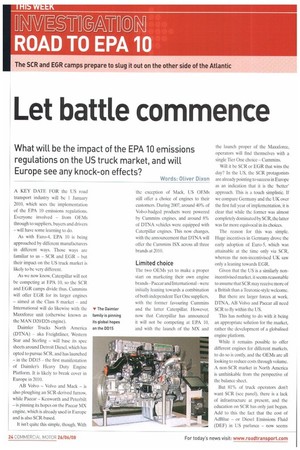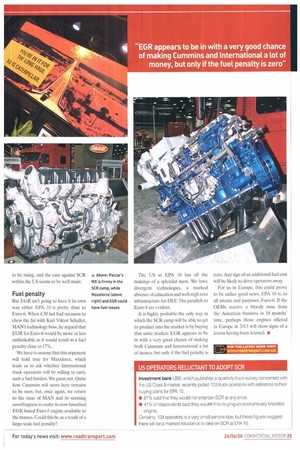Let battle commence
Page 24

Page 25

If you've noticed an error in this article please click here to report it so we can fix it.
What will, be the impact of the EPA 10 emissions regulations on the US truck market, and will Europe see any knock-on effects?
A KEY DATE FOR the US road transport industry will be 1 January 2010, which sees the implementation of the EPA 10 emissions regulations. Everyone involved from OEMs through to suppliers, buyers and drivers will have some learning to do.
As with Euro-4, EPA 10 is being approached by different manufacturers in different ways. Those ways are familiar to us SCR and EGR but their impact on the US truck market is likely to be very different.
As we now know, Caterpillar will not be competing at EPA 10, so the SCR and EGR camps divide thus. Cummins will offer EGR for its larger engines aimed at the Class 8 market and International will do likewise with the Maxxforce unit (otherwise known as the MAN D20/D26 engine).
Daimler Trucks North America • (DTNA) aka Freightliner. Western Star and Sterling will base its spec sheets around Detroit Diesel, which has opted to pursue SCR, and has launched in the DD15 the first manifestation of Daimler's Heavy Duty Engine Platform. It is likely to break cover in Europe in 2010.
AB Volvo Volvo and Mack is also ploughing an SCR-derived furrow, while Paccar Kenworth and Peterbih is pinning its hopes on the Paccar MX engine, which is already used in Europe and is also SCR-based.
It isn't quite this simple, though. With the exception of Mack, US OEMs still offer a choice of engines to their customers. During 2007, around 40% of Volvo-badged products were powered by Cummins engines, and around 8% of DTNA vehicles were equipped with Caterpillar engines. This now changes, with the announcement that DTNA will offer the Cummins ISX across all three brands at 2010.
Limited choice
The two OEMs yet to make a proper start on marketing their own engine brandsPaccar and International-were initially leaning towards a combination of both independent Tier One suppliers, with the former favouring Cummins and the latter Caterpillar. However. now that Caterpillar has announced it will not he competing at EPA 10, and with the launch of the MX and the launch proper of the Maxxforce, operators will find themselves with a single Tier One choice Cummins.
Will it be SCR or EGR that wins the day? In the US, the SCR protagonists are already pointing to success in Europe as an indication that it is the 'better' approach. This is a touch simplistic. If we compare Germany and the UK over the first full year of implementation, it is clear that while the former was almost completely dominated by SCR, the latter was far more equivocal in its choices.
The reason for this was simple. Huge incentives in Germany drove the early adoption of Euro-5, which was attainable at the time only via SCR, whereas the non-incentivised UK saw only a leaning towards EGR.
Given that the US is a similarly nonincentivised market, it seems reasonable to assume that SCR may receive more of a British than a Teutonic-style welcome.
But there are larger forces at work. DTNA, AB Volvo and Paccar all need SCR to fly within the US.
This has nothing to do with it being an appropriate solution for the market, rather the development of a glohalised engine platform.
While it remains possible to offer different engines for different markets, to do so is costly, and the OEMs are all looking to reduce costs through volume. A non-SCR market in North America is unthinkable from the perspective of the balance sheet.
But 81% of truck operators don't want SCR (see panel), there is a lack of infrastructure at present, and the education on SCR has only just begun. Add to this the fact that the cost of AdBlue or Diesel Emissions Fluid (DEE) in US parlance now seems to be rising, and the case against SCR within the US seems to be well made.
Fuel penalty
But EGR isn't going to have it its own way either. EPA 10 is pretty close to Euro-6. When CM last had occasion to chew the fat with Karl Viktor Schaller, MAN's technology boss, he argued that EGR for Euro-6 would be more or less unthinkable as it would result in a fuel penalty close to 17%.
We have to assume that this argument will hold true for Maxxforce, which leads us to ask whether International truck operators will be willing to carry such a fuel burden. We guess not. Quite how Cummins will score here remains to be seen, but, once again, we return to the issue of MAN and its seeming unwillingness to make its now-launched EGR-based Euro-5 engine available to the masses. Could this be as a result of a large-scale fuel penalty? The US at EPA 10 has all the makings of a splendid mess. We have divergent technologies, a marked absence of education and well-nigh zero infrastructure for DEF. The parallels to Euro-4 are evident.
It is highly probable the only way in which the SCR camp will be able to get its product into the market is by buying that same market. EGR appears to be in with a very good chance of making both Cummins and International a lot of money, but only if the fuel penalty is zero. Any sign of an additional fuel cost will be likely to drive operators away.
For us in Europe. this could prove to be rather good news. EPA 10 is, to all intents and purposes, Euro-6. If the OEMs receive a bloody nose from the American business in 18 months' time, perhaps those engines offered in Europe in 2013 will show signs of a lesson having been learned. •








































































































































































